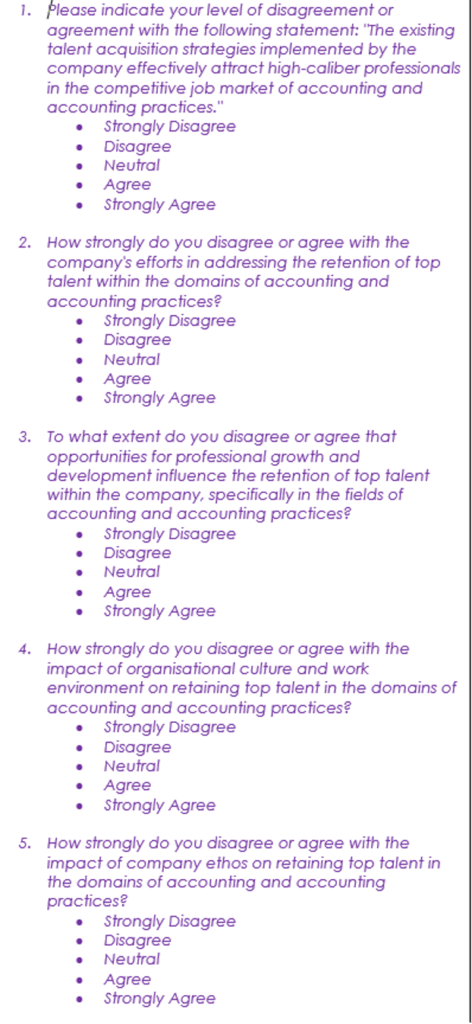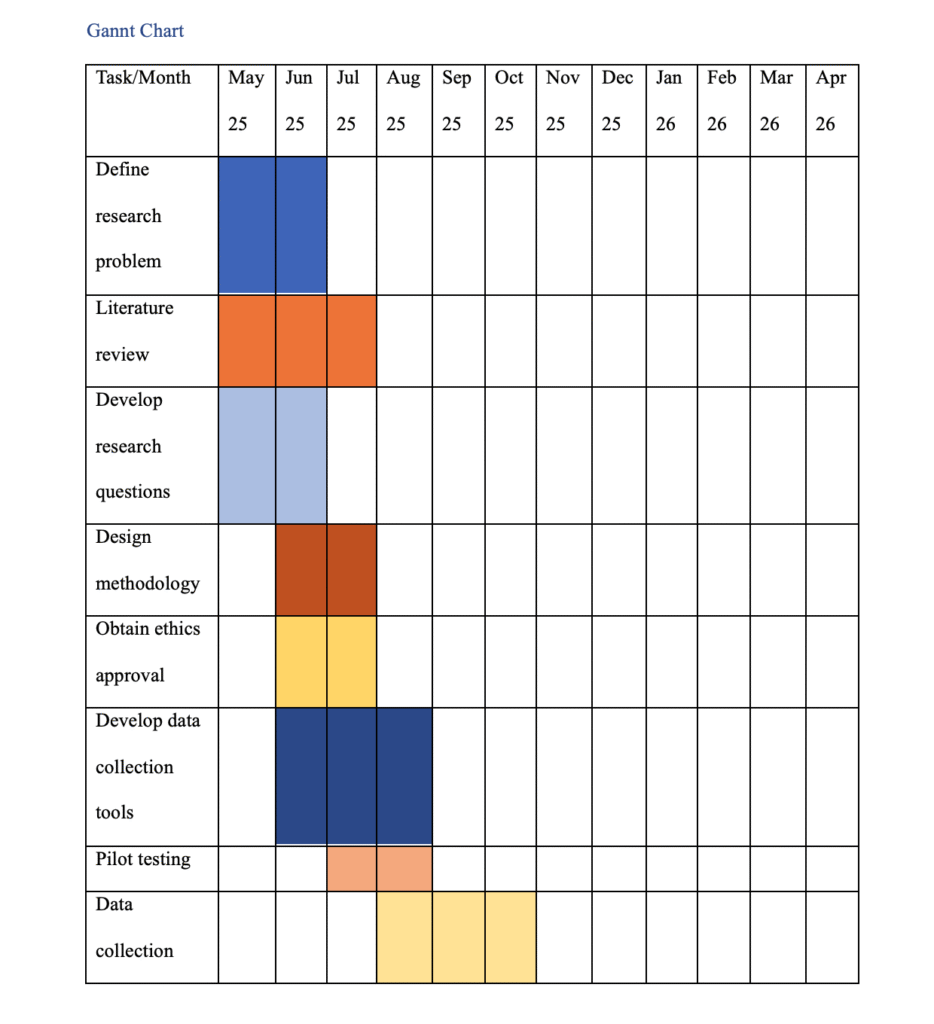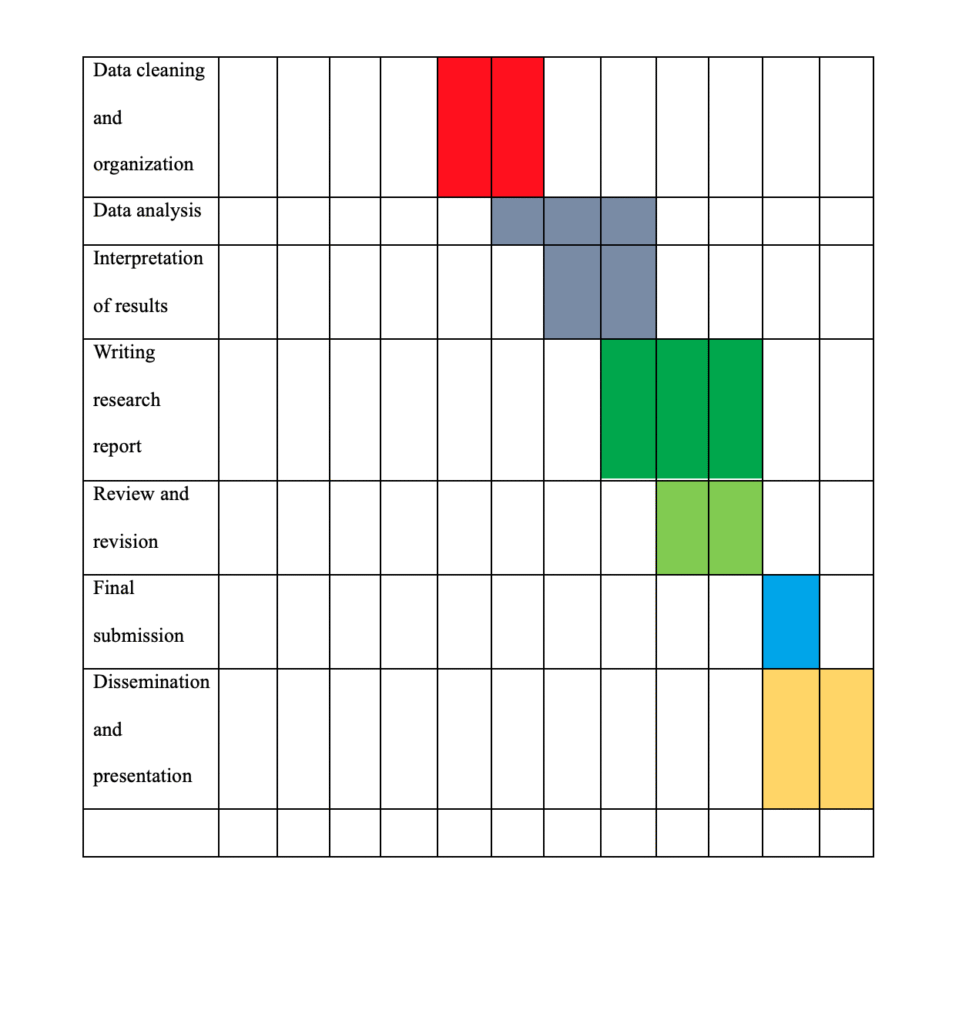Assessment task
Identify a people focused business issue that has strategic relevance to your organisation or one you are familiar with, plan and complete an original business research project that develops a set of business focused recommendations to address the identified people issue. Your research report should be approximately 4000 words and include the sections listed below. You are advised to use the section headings to help structure your report.
Background to the organisation
I work for the accounting firm Ernst & Young (EY) for Middle East & North Africa (MENA) Region. The company has a strong presence in the middle east and has offices in UAE (Dubai, Abu Dhabi), Saudi Arabia (Riyadh, Jeddah), Qatar, Oman, and Kuwait. Due to the nature of its business, it has a large accounting advisory team, which makes them highly relevant in attracting and retaining top talent in the accounting field. Therefore, the company invests significant amount in talent development, graduate recruitment, and retention strategies. Moreover, the company has publicly discussed that it is facing talent shortages in the region, there are nationalization efforts, as well as there are ongoing efforts to hit diversity goals, which align well with the focus on this research.
My Role within the organisation
In the organization, my role falls under Talent Team which is commonly referred to as Human Resources or People Advisory Services. Some of the role that I hold include Talent Acquisition Specialist / Lead – Accounting & Advisory Practice, Talent Development Advisor, HR Business Partner – Assurance / Accounting Division, Diversity, Equity & Inclusion (DEI) Specialist, and People Data Analyst (HR Analytics). Under role of Talent Acquisition Specialist / Lead – Accounting & Advisory Practice, I am responsible for recruiting top-tier professionals for EY’s accounting teams. Therefore, I develop and implement sourcing strategies for accounting roles, manage relationships with professional bodies, universities, and recruitment firms, use employer branding strategies to attract high-calibre candidates in a competitive market, and analyse recruitment data and KPIs to optimise hiring processes.
In the second role as Talent Development Advisor, my focus is Supporting retention through employee development. Under this role, my responsibility is Designing and implementing learning and development (L&D) programmes for accounting staff, facilitating career path planning and internal mobility, Measuring the impact of L&D on retention and performance, and promoting continuous learning aligned with EY’s global frameworks (e.g., EYU). As HR Business Partner – Assurance / Accounting Division, my role is Acting as a trusted advisor to business leaders on people-related issues, aligning people strategy with business goals, addressing retention issues, succession planning, and performance management, and leading talent review and workforce planning discussions. Moreover, as a Diversity, Equity & Inclusion (DEI) Specialist, I am responsible for building an inclusive culture, especially in retaining diverse talent, designing programmes to support gender balance and local talent development, Address barriers to inclusion in the accounting profession, and using employee feedback to improve belonging and retention.
Finally, I am also in charge of People Data Analyst (HR Analytics), which focusses on using data to improve talent strategies. Under this role, my responsibilities include Analysing trends in hiring, attrition, and engagement of accounting professionals, evaluating effectiveness of acquisition strategies using KPIs, and providing insights to support strategic decisions by HR and business leaders.
Business problem being addressed
The business problem being addressed is the inefficiencies or limitations of the current talent acquisition and retention strategies within the accounting practices of the company. Moreover, the research also seeks to understand the accounting practices that hinder the ability of the company to attract and retain top-tier talent in a highly competitive job market. More specifically, the three issues that the research seeks to address are as follows. First, the company is currently struggling to attract high calibre accounting professionals possibly due to the use of outdated recruitment methods, weak employer branding and competition from other accounting firms such as PWC, Deloitte, among others. Secondly, there may also be a high turnover or low retention rates among the existing accounting staff suggesting that there are underlying issues related to lack of career development opportunities, misalignment with the company culture, or inadequate reward systems. Finally, the goal of improving the strategies by 19% is quantifiable, indicating that there is a current gap in performance that requires an urgent solution to meet the objectives of the business such as productivity, service quality, and continuity in client relationships.
Terms of Reference
Research Aim
The aim of the study is to evaluate and enhance the effectiveness of the company’s talent acquisition and retention strategies in accounting practices, with the goal of increasing the attraction and retention of top talent by 19%. In particular, the study seeks to focus on accounting practices, the dual emphasis on attraction and retention of top talent, the quantitative goal of a 19% improvement, and the overarching intention to assess and improve strategies.
Where in the organisation the research will take place
The study will take place within the confines of the organization. It will use participants working in the company including using internal records and data.
Resources
It is estimated that the research will use USD 1300. Other resources that will be used include time to interview the participants, identifying them, etc.
Timeframes
The timeframe for the study is provided in details in the GANTT chart in the appendix section of the paper.
Literature Review
For any organization to achieve effective talent acquisition, it is critical to build a high-performance workforce which, in turn, give the company a competitive edge over rivals. This is important because the modern operating environment is highly competitive. In fields such as accounting, this is especially the case because accounting is a highly specialized field that requires technical talent. Therefore, to enhance talent acquisition, organizations need to invest in employer branding, competitive compensation and benefits, structured recruitment processes, campus recruitment and internship programs, use of technology and data analytics, employee referral programs, offering opportunities for career development, work-life balance and flexibility, and a strong onboarding and engagement.
Hongal & Kinange (2020) notes that talent is the main source of competitive advantage for firms. According to the study, the performance of an organization is dependent on the performance of its employees. Therefore, if the employees are highly skilled and has unique competencies, it makes the organization differentiate itself from the competitors. Therefore, the main task of people professionals or HR managers it creating an environment within the organization where talent retention is possible. However, that process started with undertaking or implementing the right talent acquisition strategies to attract the right people with the required skills. Thus, what is apparent is that the HR role within the organization is very strategic as it helps the organization achieve its strategic goal.
The issue of talent retention is every more critical during and after merger. This happens because mergers create periods of uncertainty within the organization, increasing intention to leave. Using evidence from China, Zhang et al. (2014) investigated the factors that lead to increases chances of talent retention in firms and found that leadership plays a critical role. The study found that the best type of leadership for talent retention during mergers is coaching style and incentive structure. Also, the study found that task focussed leaders could use their position to identify talented employees and provide the right incentives to retain them. Moreover, the study also found that relationship focussed leaders could use the concept of guanxi network to foster communication and engage with talented employees, further providing incentive to retain them.
The role of technology is gaining significant use and traction in management of employees especially in relation to acquisition and retention. According to Johnson et al. (2020), some of the most important of those technologies are AI and electronic human resource management (eHRM). With these technologies, HR managers can screen applications faster and identify those with attitudes or personality that is likely to make them succeed in their roles. In talent acquisition, using AI, especially custom AI, the HR managers can identify the profile of employees likely to leave the organization and implement strategies meant to reduce turnover and thus boost overall retention. Therefore, the role of technology is important to the modern organization in talent management especially in relation to retention.
Ibidunni et al. (2016) conducted a study in the banking industry to identify the factors that contributed to talent retention. The study used a sample size of 185 participants and Structural Equation Modelling (SEM) used to obtain correlation and regression. The study found that the most important factors that increase talent retention are salary, bonus, incentives, reward, and profit sharing. Therefore, it is important for organization to offer employees good compensation which include offering them bonuses, incentives, reward, and profit sharing. A combination of those factors ensures that employees remain committed to the organization and show high level of involvement. The study found that commitment and involvement are associated with higher levels of retention.
Another study by Schiemann (2014) found that talent retention has important implications in various dimensions. Those dimensions are turnover, financial performance, quality, productivity, customer retention, and organizational processes and policies. High turnover means that the organization is not able to retain employees and it imposes higher cost on recruitment and training new employees. Moreover, high turnover is associated with lower productivity and poor customer retention. Therefore, it is important for the organization to put in place measures or processes and policies to boost retention. Those actions should be retention. For those companies that are able to optimize the process of employee retention, they profit by gaining a competitive advantage over rivals.
According to the findings of Pandita & Ray (2018), there is a link between talent management and employee engagement. The study found that the most effective tools for ensuring that employees remained engaged and committed to their work is talent management. Talent management includes various components such as attracting talent, developing talent, engaging talent, retaining talent, and succession planning. This demonstrates that talent management is an involving process composing of various dynamics. The study found that companies need to invest time and resources to refine their talent management strategies. Doing that improves the overall quality of human capital which, in the long run, allows companies to improve their overall performance.
Before organization can work to retain talent, they need to recognize talented employees first. However, to achieve that objective, companies use various or different methods. A study by Boštjančič & Slana (2018) sought to examine the most prevalent methods used by companies to recognize talent. Using structured interviews, the study found that the most widely used methods are annual evaluation interviews which seeks to measure the meeting of targets by employees. The evaluations are conducted by managers and they are done at specific intervals. However, the same study found that there are also challenges associated with attracting talent and the important one is positioning the organization as a desirable employer. When employees seek employment, they consider the reputation of the employer.
As already mentioned, the accounting field is highly technical and requires people with technical skills that takes time and effort to acquire. Zaharee et al. (2018) investigated work environments and cultures that tend to attract early career technical talent and found access competitive salaries, healthcare benefits, professional development plan, flexible hours, and ability to work remotely. Therefore, this suggests that organizations that wishes to attract highly talented accountants need to provide an array of benefits and other things to make the employer attractive. Offering these things also makes it easier for the organization to retain top talent as well.
In summary, talent retention is important. However, what is required for employees to have the right strategy in place. This literature review has conducted an appraisal of the different approaches to talent management and finds it is important to talent retention.
Research Questions
- What are the current talent acquisition methods employed by the company in the field of accounting?
- How effective are the existing strategies in attracting high-calibre professionals in the competitive accounting job market?
- What key factors influence the retention of top talent within the company, particularly in the accounting domain?
Research methodology
Research Strategy
The study used quantitative research strategy. This approach is justified because it provides measurable insights into employee perceptions and experiences related to talent acquisition and retention (Beauchamp & Childress, 2013). Given that the objective of the study is to investigate strategies to achieve a quantifiable goal, then quantitative approach is justified.
Research Design
The research design adopted in this study is Cross-Sectional Research Design whose purpose is to gather data at a single point in time. The goal is to get a general overview of the issue under investigation. The study also used case study design as well because it focussed on the experiences of a single company. The methods are justified because the objective of the study is to get a snapshot of the issue under investigation at a specific period in time (Bera, 2018). In the case of case study design, it fits within the objective of the study, which is to study the topic within the context of EY.
Primary Research Methods
The research methods used is employee surveys or quantitative and the target group is employees in accounting functions. The purpose is to gather data on perceptions of recruitment effectiveness, professional development, culture, and retention factors. This approach is justified because it allows for statistical analysis which, in this case, used descriptive statistics.
Research population and sample
The research population in this study is the employees undertaking accounting functions in the organization. It is from this population that the study collected a sample. Based on the size of the study population, a sample of 4 participants was deemed appropriate.
Sampling Methods
The sample was collected using simple random sampling. Random sampling is a method which ensures that each member of the population has an equal chance of inclusion into the study (BPS, 2014). This approach is justified because it ensures that the results of the study can be generalized to the study population. For simple random sampling, it was selected or used because it is easy and cost effective to execute.
Ethical Issues
Informed Consent
In this study, the participants were informed about the purpose of the research, what participation involves, potential risks and benefits, and the right to withdraw from the study at any time. This is justified because it ensures that voluntary participation and autonomy.
Confidentiality and Anonymity
To ensure this, the personal data collected from the participants was kept confidential. The participant identities were protected by using code names instead of names. This is justified because it helps build trust and protects the privacy of the participants (Bryman, 2016).
Avoidance of Harm
The researchers made sure that the study did not cause any physical, psychological, emotional, or reputational harm to the participants. This was justified because it ensures that participant safety and ethical responsibility was met (Bryman, 2016).
Voluntary participation
The study ensured that participation into study was free of coercion, pressure, or manipulation. This was justified because it respected the freedom of the participants to make a choice.
Right to withdraw
The participants could withdraw from the study at any time of their choosing without providing any explanation or facing negative consequences. This was justified because it respected the autonomy and consent of the participants.
Data protection
Efforts were made to protect the data collected from the participants in accordance with the law. In this case, the relevant law is GDPR (Bryman, 2016). Consequently, the data was stored in a secure place and protected using a password. Later, after publication of the findings, it was deleted from the servers.
The main ethical principles considered in the study
Avoidance of Harm (Non-Maleficence)
The research design was carefully constructed to avoid physical, emotional, or psychological harm. The questions asked were non-invasive, and the environment in which the data were collected was safe and respectful (Creswell & Creswell, 2018).
Integrity and Transparency
The research was conducted with honesty, and findings were reported accurately without fabrication or misrepresentation (Creswell & Creswell, 2018). Any potential conflicts of interest were managed appropriately.
Justice
Participants were selected fairly and equitably, ensuring that no group was unfairly burdened or excluded from the potential benefits of the research (Saunders, Lewis & Thornhill, 2019).
An analysis and presentation of the data collected from the primary research
The data used in the analysis was collected from 4 participants and was analysed using Microsoft excel. The following are the results.
Experience Level of Respondents
Table of results
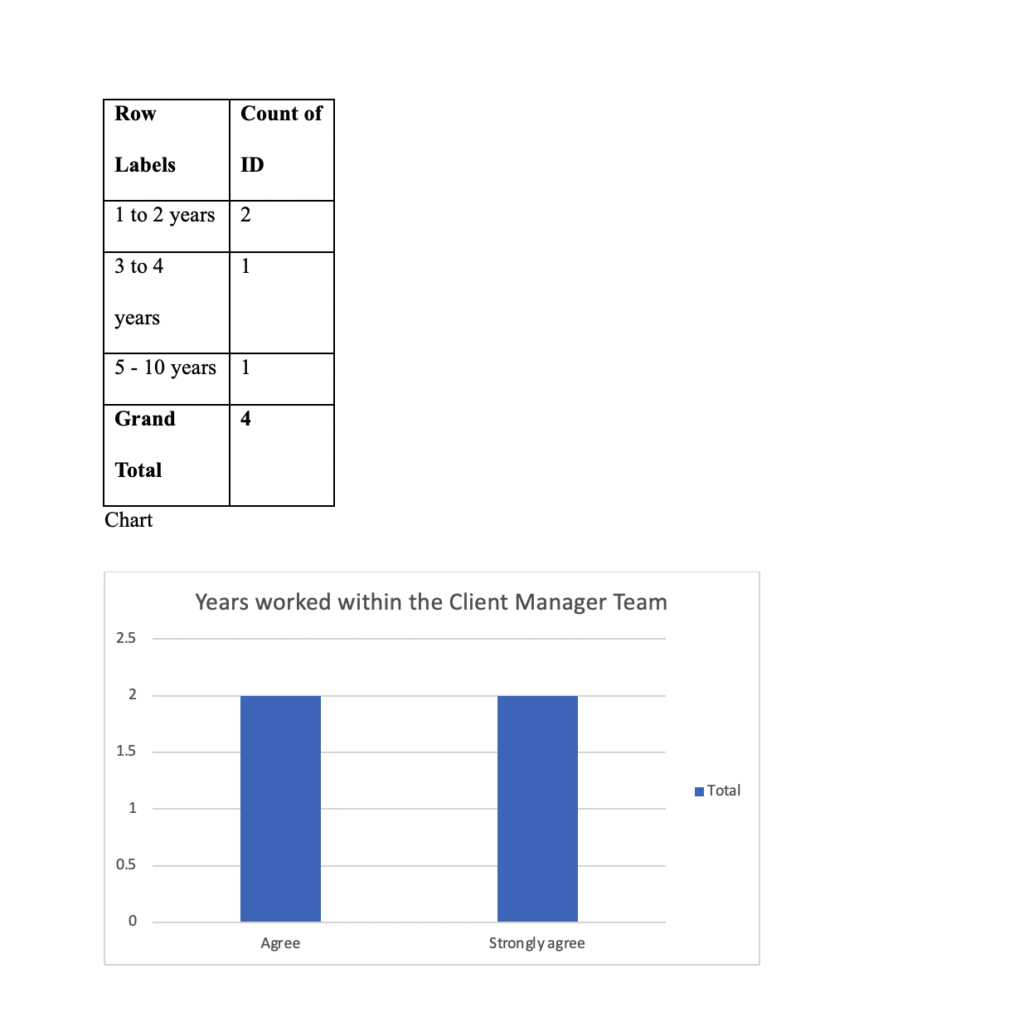
The results show that the respondents have varying lengths of experience in the Client Manager Team: One with 5–10 years, One with 3–4 years, Two with 1–2 years. This diversity in the number of years worked allows for a range of perspectives from both newer and more seasoned staff.
Perceptions of Talent Acquisition Strategies
Table of Results
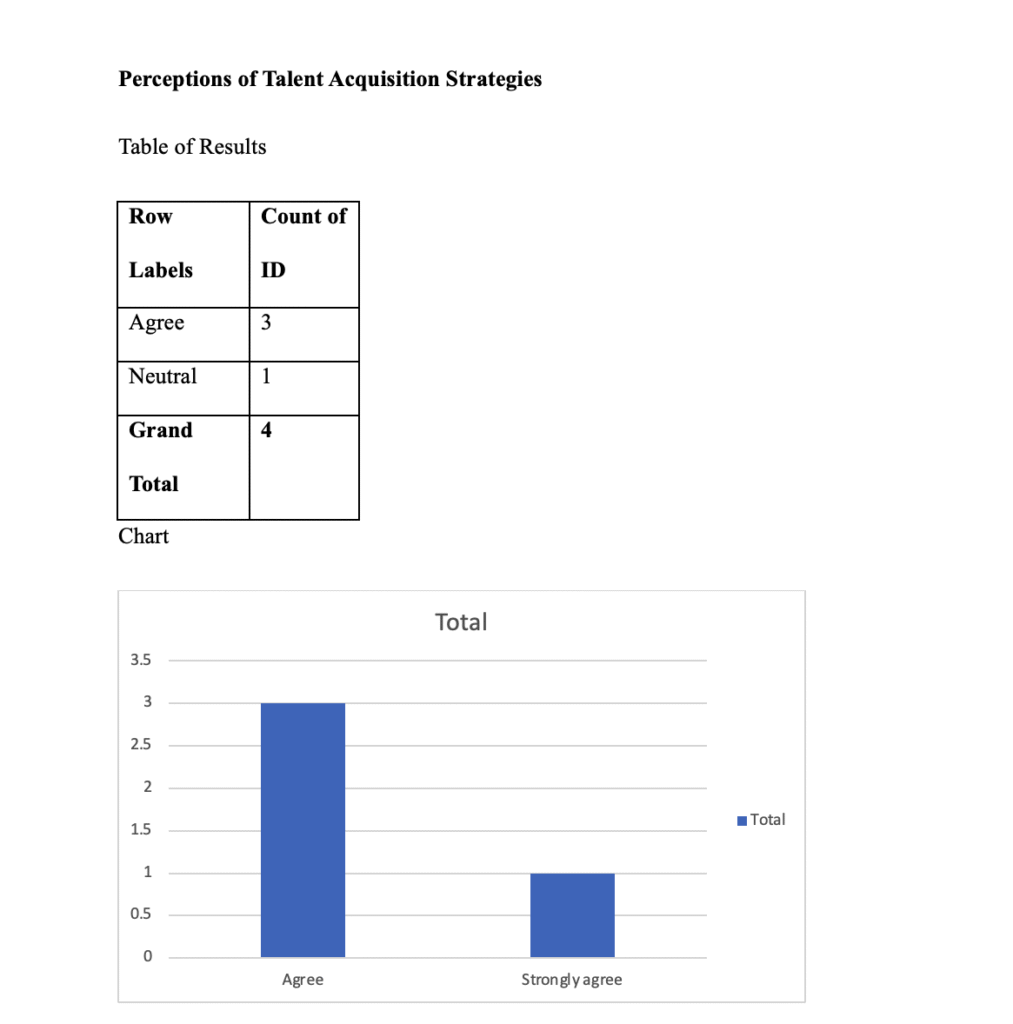
According to the results, 3 out of 4 participants either agreed or strongly agreed that the existing strategies effectively attract high-calibre professionals. However, 1 participant (with 1–2 years’ experience) responded neutrally. The implication is that in general, there is general satisfaction, though newer employees may be more cautious or less familiar with the full scope of the strategies.
Retention of Top Talent
Table of Results
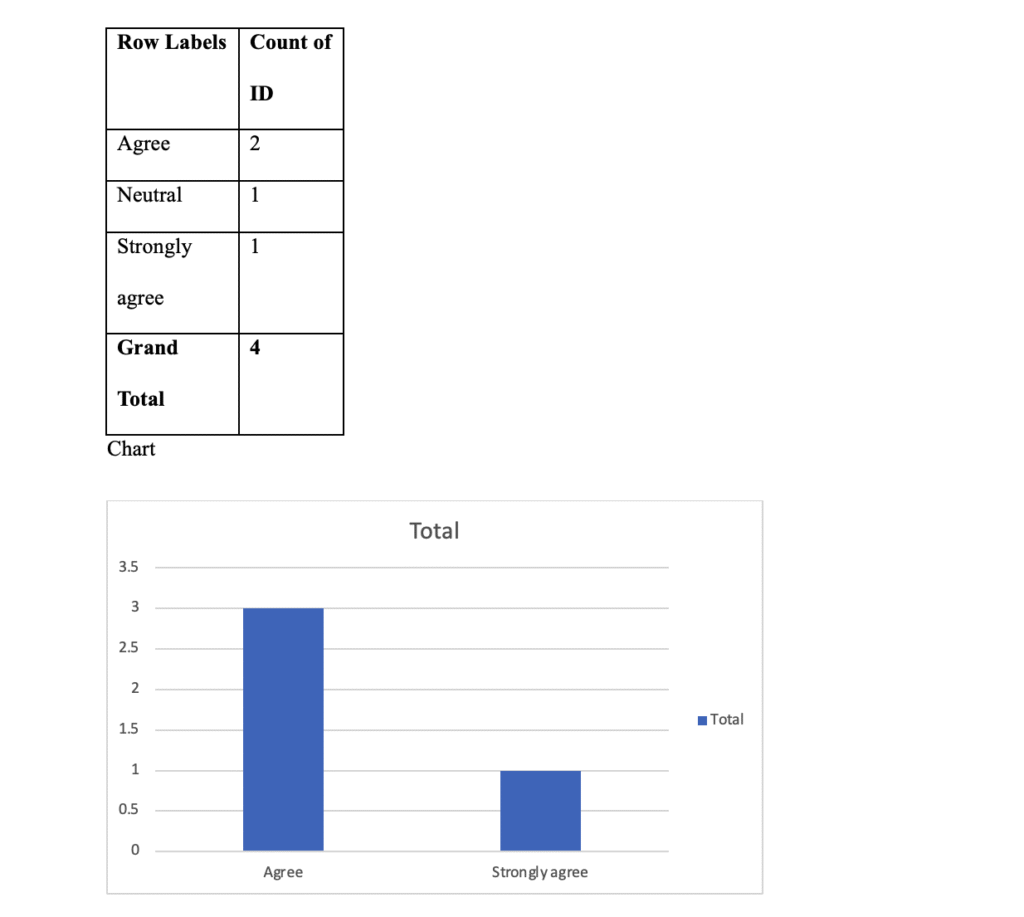
The findings as per the table and the chart shows that 3 participants agreed or strongly agreed that the company addresses retention of top talent well. However, 1 participant responded neutrally (same person as above). This again suggests overall positive feedback, though perhaps room for greater engagement or communication, especially with newer staff.
Impact of Organisational Culture & Work Environment
Table of Results
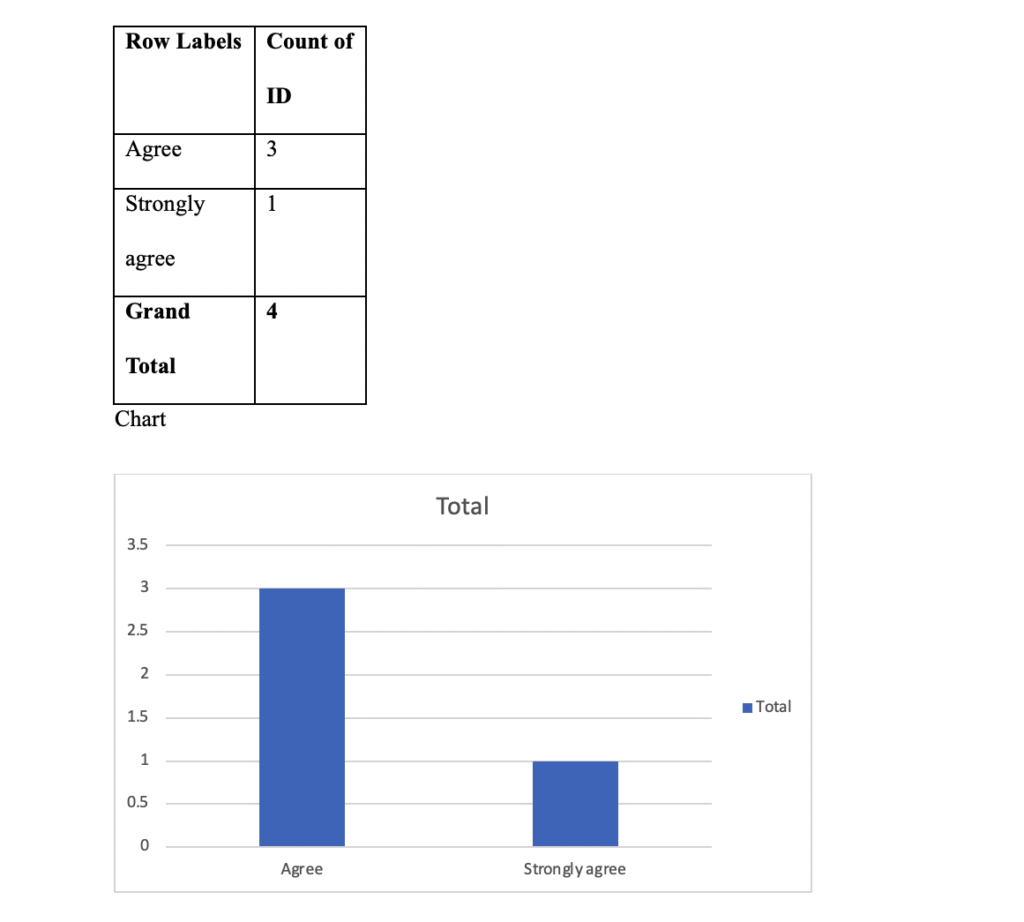
All participants agreed or strongly agreed on its impact. This highlights consensus on the positive or significant role of culture and work environment in retention.
Impact of Company Ethos
Table of Results
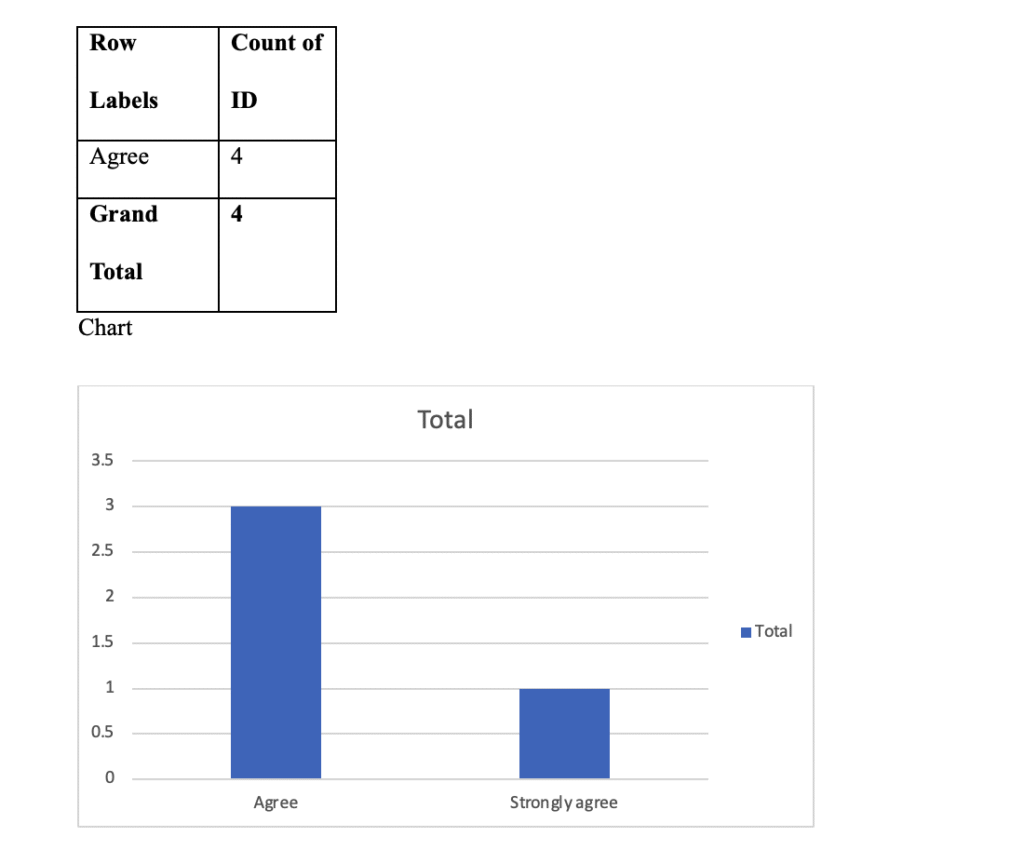
Results show that all participants agreed that company ethos has an impact on retaining top talent. Again, this signals a shared belief in the influence of core values and identity in staff retention.
A discussion of the research findings
The results of descriptive statistics show that in all the areas examined, they had an impact on the topic of the study. Therefore, the results indicate that participants, regardless of experience level, generally perceive the company’s talent acquisition and retention strategies positively. Also, there is strong agreement on the importance of growth opportunities, culture, and ethos in retaining top accounting talent. The neutral responses from the newer employee may indicate areas where onboarding, communication, or engagement could be enhanced to fully align them with more experienced staff’s perceptions.
The aim of this study was to assess and improve the company’s talent acquisition strategies to attract and retain top talent in the accounting practice by 19%. According to the findings of the study, the most effective strategies for attracting and retaining talent are competitive compensation and benefits, structured recruitment and onboarding processes, investment in employer branding, professional development opportunities, and offering flexible work arrangements. These findings align with the literature review on talent acquisition and retention in professional services especially in accounting field.
From the literature, Ibidunni et al. (2016) identified salary, bonuses, incentives, and profit-sharing as major contributors to retention. Similarly, Zaharee et al. (2018) noted that competitive salaries and healthcare benefits are especially important in attracting early-career technical talent, including accountants. This suggests that financial incentives remain a core driver of both attraction and retention across industries and job levels.
The study also found that employer branding and structured recruitment processes enhance the effectiveness of talent acquisition. This supports the arguments of Boštjančič & Slana (2018), who highlighted the challenge of positioning the organization as a desirable employer and the widespread use of evaluation interviews to recognize and engage talent. Moreover, Hongal & Kinange (2020) emphasized that talent is the main source of competitive advantage and that HR professionals must implement the right strategies to attract and retain skilled individuals, validating the strategic importance of branding and process structure.
In line with findings from Zhang et al. (2014), the role of leadership was also significant in our study. Respondents indicated that leadership communication and mentorship played a key role during uncertain times such as organizational changes. This is consistent with Zhang et al.’s observation that coaching and relationship-focused leadership styles are effective in retaining talent, particularly during transitions like mergers.
The study also highlighted the growing role of technology and analytics in identifying and managing talent, including the use of applicant tracking systems and predictive retention tools. This aligns well with Johnson et al. (2020), who underscored the importance of AI and electronic human resource management (e-HRM) in modern talent acquisition and retention strategies.
Importantly, the findings emphasized that career development opportunities and work-life balance significantly affect employee engagement and long-term commitment. This supports Zaharee et al. (2018), who identified flexible hours, remote work options, and professional development plans as essential components of attractive work environments. Similarly, Pandita & Ray (2018) found that talent management, particularly development and engagement—is strongly linked to retention outcomes.
Conclusion
The goal of this research was to evaluation how EY talent acquisition strategies that improve attraction and retention of the top talent in its accounting practice. This was done through a combination of primary data collection and analysis of existing literature. The results provided several key insights that aligns with the aim of the study. According to the primary research, the most influential factors are competitive compensation, strong employer branding, structured recruitment, onboarding processes, leadership engagement, and opportunities for career progression. Therefore, the key takeaway from the study is that financial incentives are important but in the longer term, what matters most is organizational culture, support systems, and perceived career growth.
The review of literature also agrees with the findings of the primary research. Studies by Ibidunni et al. (2016) and Zaharee et al. (2018) underscored the importance of financial rewards and flexible work options in attracting technical talent, while Johnson et al. (2020) emphasized the growing role of technology in identifying and managing talent. Hongal & Kinange (2020) and Schiemann (2014) framed talent as a core strategic asset, reinforcing the need for people professionals to align HR practices with overall business goals. Furthermore, the role of leadership, especially during periods of uncertainty, was validated by Zhang et al. (2014), who found that coaching and relationship-based leadership styles were effective in retaining employees.
Recommendations
The following are the recommendations.
- Enhance Employer Branding through Targeted Campaigns
Action: Launch a digital branding campaign showcasing the company’s culture, values, and career progression opportunities across LinkedIn, professional networks, and university platforms.
Evidence: Literature (Hongal & Kinange, 2020; Boštjančič & Slana, 2018) affirms that a positive employer brand enhances attractiveness to top talent.
Business Impact: Improved brand visibility could reduce cost-per-hire and increase high-quality applications by at least 25%.
- Develop Structured Internship and Graduate Programs
Action: Partner with top universities to develop rotational internships and graduate schemes for early-career accountants.
Evidence: Literature (Zaharee et al., 2018) suggests early career talent prioritizes professional development and structured entry routes.
Business Impact: Early engagement could reduce first-year turnover and increase retention of trained graduates by 30%.
- Implement Competitive Total Reward Packages
Action: Benchmark and redesign compensation packages to include performance bonuses, flexible benefits, healthcare, and profit-sharing schemes.
Evidence: Ibidunni et al. (2016) and Schiemann (2014) confirm that attractive financial and non-financial rewards drive retention and performance.
Business Impact: Could reduce turnover costs (recruitment, onboarding, training) by up to 40% and increase productivity and morale.
- Leverage AI and e-HRM Tools in Recruitment
Action: Integrate AI-based applicant tracking systems and predictive analytics to screen and identify high-fit candidates.
Evidence: Johnson et al. (2020) highlights the growing use of AI in efficient and effective talent acquisition.
Business Impact: Could decrease time-to-hire by 30% and increase retention through better fit and forecasting of turnover risk.
- Provide Coaching-Based Leadership Development
Action: Train managers in coaching and relationship-based leadership to support talent retention and development, especially during change or uncertainty.
Evidence: Zhang et al. (2014) found this leadership style effective during mergers and transitional periods.
Business Impact: Higher employee engagement and psychological safety can increase retention and internal mobility.
References
Beauchamp, T.L. & Childress, J.F. (2013). Principles of Biomedical Ethics (7th ed.). Oxford University Press.
Bera (2018). Ethical Guidelines for Educational Research. British Educational Research Association.
Boštjančič, E., & Slana, Z. (2018). The role of talent management comparing medium-sized and large companies – major challenges in attracting and retaining talented employees. Frontiers in Psychology, 9. https://doi.org/10.3389/fpsyg.2018.01750
BPS (2014). Code of Human Research Ethics. British Psychological Society.
Bryman, A. (2016). Social Research Methods (5th ed.). Oxford University Press.
Creswell, J. & Creswell, D. (2018). Research Design: Qualitative, Quantitative, and Mixed Methods Approaches (5th ed.). SAGE Publications.
Hongal, P., & Kinange, Dr. U. (2020). A study on talent management and its impact on organization performance- an empirical review. International Journal of Engineering and Management Research, 10(01), 64–71. https://doi.org/10.31033/ijemr.10.1.12
Ibidunni, S., Osibanjo, O., Adeniji, A., Salau, O. P., & Falola, H. (2016). Talent retention and organizational performance: A competitive positioning in Nigerian banking sector. Periodica Polytechnica Social and Management Sciences, 24(1), 1–13. https://doi.org/10.3311/ppso.7958
Johnson, R. D., Stone, D. L., & Lukaszewski, K. M. (2020a). The benefits of EHRM and AI for Talent Acquisition. Journal of Tourism Futures, 7(1), 40–52. https://doi.org/10.1108/jtf-02-2020-0013
Johnson, R. D., Stone, D. L., & Lukaszewski, K. M. (2020b). The benefits of EHRM and AI for Talent Acquisition. Journal of Tourism Futures, 7(1), 40–52. https://doi.org/10.1108/jtf-02-2020-0013
Pandita, D., & Ray, S. (2018). Talent management and employee engagement – a meta-analysis of their impact on talent retention. Industrial and Commercial Training, 50(4), 185–199. https://doi.org/10.1108/ict-09-2017-0073
Saunders, M., Lewis, P. & Thornhill, A. (2019). Research Methods for Business Students (8th ed.). Pearson Education.
Schiemann, W. A. (2014). From talent management to talent optimization. Journal of World Business, 49(2), 281–288. https://doi.org/10.1016/j.jwb.2013.11.012
Zaharee, M., Lipkie, T., Mehlman, S. K., & Neylon, S. K. (2018). Recruitment and retention of early-career technical talent. Research-Technology Management, 61(5), 51–61. https://doi.org/10.1080/08956308.2018.1495966
Zhang, J., Ahammad, M. F., Tarba, S., Cooper, C. L., Glaister, K. W., & Wang, J. (2014). The effect of leadership style on talent retention during merger and Acquisition Integration: Evidence from China. The International Journal of Human Resource Management, 26(7), 1021–1050. https://doi.org/10.1080/09585192.2014.908316
Appendix
Survey Questions
